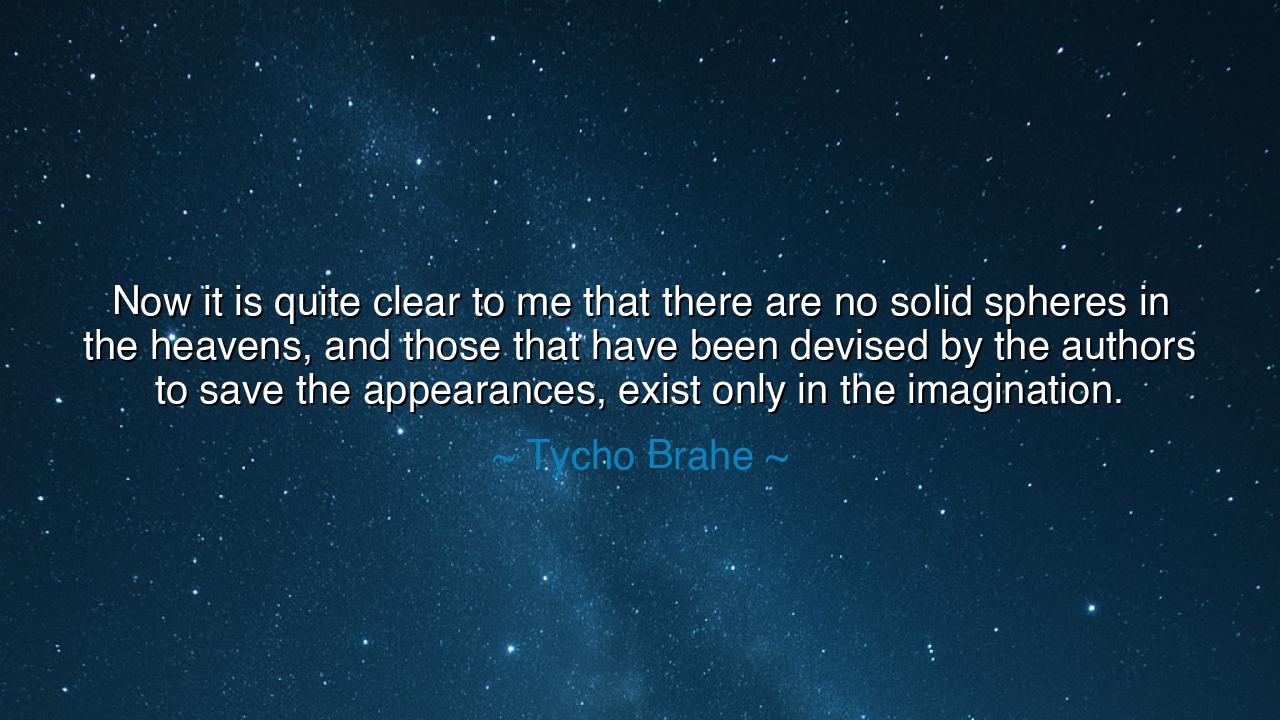
Now it is quite clear to me that there are no solid spheres in
Now it is quite clear to me that there are no solid spheres in the heavens, and those that have been devised by the authors to save the appearances, exist only in the imagination.






“Now it is quite clear to me that there are no solid spheres in the heavens, and those that have been devised by the authors to save the appearances, exist only in the imagination.” Thus declared Tycho Brahe, the great Danish astronomer of the sixteenth century — a man whose eyes were among the first to pierce the ancient illusion of the cosmos. In these words, he speaks as one who stood upon the threshold between the old world and the new, between myth and science, between the imagination that once shaped the heavens and the observation that began to unveil their truth. His statement, though modest in tone, was revolutionary in spirit, for it marked the breaking of chains that had bound human thought for nearly two thousand years.
For in the age before Tycho, the universe was thought to be built upon crystal spheres, solid and divine, carrying the planets and stars in perfect circles around the Earth. This was the vision of Ptolemy, inherited by scholars and priests alike, and defended as sacred truth. The spheres, transparent and incorruptible, were said to make the music of the heavens — a grand harmony of motion designed by God Himself. To question their existence was to question the order of creation. Yet Tycho, with his instruments and his relentless gaze, saw with his own eyes that the heavens did not obey this ancient order. Comets moved freely through what should have been impenetrable crystal; planets wandered in ways no solid spheres could explain. Thus, he proclaimed that these spheres existed only in the imagination — beautiful, yes, but false.
This was no small statement, for in saying it, Tycho was not merely correcting an error of astronomy; he was challenging the way humanity understood truth itself. The imagination, once considered the vessel of divine revelation, had built the architecture of the heavens. The ancients had seen patterns in the stars and woven them into myth; philosophers had turned those myths into models of the cosmos. The spheres were not born of evidence, but of the human need for perfection — for symmetry, for order, for a universe that mirrored the harmony we long for in our souls. Tycho’s discovery shattered that illusion. He showed that the imagination, though wondrous, must sometimes yield to observation, lest it become a prison for truth.
Yet, let us not mistake his meaning. Tycho did not scorn the imagination; he honored it. For without imagination, mankind would never have reached for the stars at all. It was imagination that first looked upward and asked, “What lies beyond?” It was imagination that made of the night sky a cathedral of light. But imagination without discipline, without humility before reality, leads astray. The crystal spheres, though false, had once served a noble purpose — they gave shape to wonder. Tycho’s wisdom lay in knowing when to let them go. His courage was not in rejecting imagination, but in freeing it — in allowing it to grow beyond its own limits, to imagine not what must be, but what might be.
Consider, then, the irony: the imagination that once built the illusion of the spheres was the same power that led Tycho to destroy them. For imagination can err, but it can also evolve. When joined with reason, it becomes the mother of discovery. In the centuries after Tycho, men like Kepler and Galileo would build upon his insights, and from their union of observation and imagination, the true music of the cosmos would emerge — not from the spinning of crystal shells, but from the invisible dance of gravity and motion. The heavens, once thought to be rigid and perfect, were revealed to be infinite and alive.
Tycho’s revelation carries a timeless lesson for all who seek truth. There are still “spheres” in our minds — ideas we mistake for certainties, beliefs we cherish not because they are true, but because they are beautiful. Whether in science, in faith, or in daily life, we must have the courage to test them, to see whether they are solid or only imagined. This does not mean abandoning imagination, but refining it — letting it serve truth, not confine it. The imagination is the lamp that guides our journey, but the light of reality must show the path.
So, O seeker of wisdom, remember this: the imagination is a divine gift, but it must bow before evidence. Build your visions, but be ready to unbuild them. Love your beliefs, but dare to question them. For truth, like the stars, shines brightest when the clouds of illusion have cleared. Let Tycho’s courage be your own — to look at the heavens, at the world, and at yourself, and say, “What I have believed may be only in my imagination.” Then, with new eyes, you will see — not a smaller universe, but a greater one, infinite and unfolding, where imagination and truth dance together in eternal creation.






AAdministratorAdministrator
Welcome, honored guests. Please leave a comment, we will respond soon